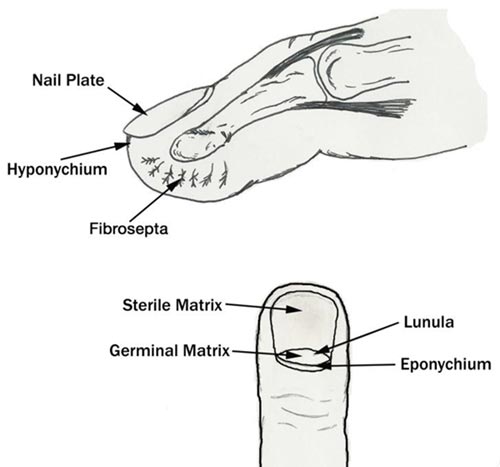
Finger Nail Injuries
If the finger nail gets crushed, bleeding may occur underneath it. If this bleeding doesn’t hurt, it probably doesn’t need to be drained. It will resorb over time. However, if the bleeding is painful, the pain is probably from the underlying nail bed, the tissue that forms the nail and allows it to adhere to the finger, being injured by the pressure. In this case, it should be drained by burning a hole through the nail to release the blood trapped beneath it. In an emergency room, cautery devices are usually available to do this. In a physician’s office, the usual technique is to heat up a paper clip with a cigarette lighter and use it to burn through the nail. This takes a few minutes, but is painless. Upon completing the hole through the nail, the blood underneath cools the paper clip and so the underlying nail bed is not burned. As no one in my office smokes (or at least, no one will admit to smoking) if you come into my office for this, it is helpful to bring a cigarette lighter with you.
If the nail has been avulsed (torn out from underneath the nail fold), it should usually be replaced underneath nail fold for 2 weeks to avoid scarring of the cuticle/nail fold to the nail bed, which can lead to a nail deformity. The nail is usually relocated in the office under a digital block, which numbs the finger. Part of the nail is removed to make it fit back easier and then the nail is replaced and held in position with steristrips (tape). The digit is splinted for two weeks, as bending the finger may cause the nail to pop out again. After 2 weeks have passed the nail can be allowed to grow out or fall out, depending on how badly it was avulsed.
In a child, nail avulsion is often associated with a fracture through the growth plate of the bone underneath the nail. These fractures are ‘open’, i.e. exposed to the environment, and can become infected. These injuries should be washed out in an emergency room or office, antibiotics prescribed and the fracture fixed in the operating room within a few days. This is an outpatient procedure. Usually a pin is used to hold the fracture in place. The digit is splinted, usually for 3 weeks, and then the pin is removed in the office; pin removal doesn’t hurt very much, and is nothing to be feared.
If the nail has been cut or damaged, then the underlying nail bed is often cut as well. Any underlying bony fracture should be fixed in better position to provide a smooth surface for the nail bed. The nail bed should be repaired to minimize the resulting nail deformity. As above, the nail, or a substitute, is placed underneath the nail fold for at least 2 weeks and can then be removed. The new nail that grows will always have some degree of deformity, but good treatment should minimize any problems.

